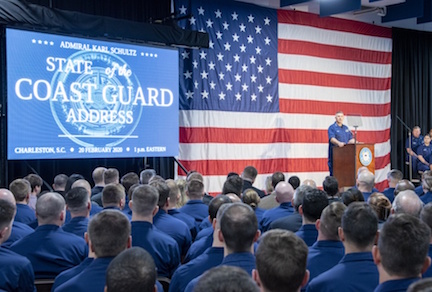The following is text of a news release from the U.S. Coast Guard:
(WASHINGTON) — The commandant of the U.S. Coast Guard outlined the vision for the service and highlighted the accomplishments of its people during today’s 2020 State of the Coast Guard Address in Charleston, S.C.
During his annual address, Adm. Karl Schultz reflected on the organization’s successes over the past year and President Trump's fiscal year 2021 budget request. He also outlined plans to expand the Coast Guard’s footprint in the Charleston area by home-porting five national security cutters and potentially becoming a future home of the service’s offshore patrol cutter, currently under construction.
“Charleston is a first stop to nationwide investment in our service, our facilities, and our people,” Schultz told attendees Thursday. “To serve the communities in which we live, we need early adopters like you here today.”
The service chief provided updates on the acquisition timeline for the polar security cutter and offshore patrol cutter. Along with these acquisition updates, the Coast Guard will restore hurricane-damaged facilities in South Carolina and seek to expand its operations based in the “Lowcountry.” The Coast Guard is currently carrying a nearly $2 billion shore infrastructure backlog, and in one example, he explained how flooding affected operations at Coast Guard Station Niagara (N.Y.), which was pumping more than 200,000 gallons of water from its facility daily last spring.
“Every mission begins and ends at a Coast Guard facility,” said Schultz. “Unfortunately, due to years of flat-line budgets forcing tradeoffs, the facilities that our men and women deploy from and return to are crumbling around them.”
Schultz shared his vision for talent management in the service. Specifically, he outlined several personnel initiatives to recruit and retain a highly skilled workforce. This includes a Coast Guard underrepresented minority study to better understand recruiting and retention dynamics and a Coast Guard Diversity and Inclusion Action Plan to foster a more inclusive culture. He announced a workforce readiness website, called “My Coast Guard,” delegated meritorious advancement authority to field commanders, and expanded the enlisted marine inspector training program.
“Talent management is both our most pressing challenge and our greatest opportunity,” said Schultz, flanked by Coast Guard service members. “That is why I believe wholesale investment will enable our talented people to carry out their missions across the maritime domain today and tomorrow.”
During the address, he meritoriously advanced Petty Officer 2nd Class Nathan Newberg of Coast Guard Air Station Savannah (Ga.) and Petty Officer 2nd Class Emily Ford of Coast Guard Operation Bahamas, Turks and Caicos in Nassau, Bahamas. Schultz also recognized numerous Coast Guard members for their stellar performance “Stories Behind the State of the Coast Guard.”
The Coast Guard’s enduring and specialized role in the Indo-Pacific was also highlighted. The service will expand its permanent presence in the region through expeditionary capability, work with its partner nations to address the security challenges in the region, and build capacity and capability.
The commandant rolled out the service’s “Tech Revolution” road map, a detailed plan to update the Coast Guard’s 1990s-era hardware, software, and analytics. He also described the need to strengthen service innovation initiatives and accelerate implementation of the best ideas servicewide to field commanders. These include the marine inspector mobility application INSPECT, partnering with Global Fish Watch to combat illegal fishing, linking to the DoD’s Defense Innovation Unit in Silicon Valley, and the establishment of the Blue Technology Center of Expertise at the University of California San Diego.
Other initiatives discussed were the Coast Guard’s cyberstrategy, improving cutter connectivity, and modernizing the Coast Guard Auxiliary’s information technology capabilities.
To read the entire speech, go to www.uscg.mil/AlwaysReady.

